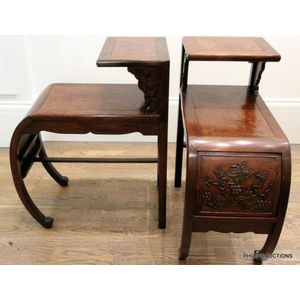Rosewood and Burl Chinese Side Tables, Early 20th Century
A pair of rosewood and burl two tier side tables, early 20th century the pair of Chinese side (or bedside) tables, each with upper shelf inset with burl wood panel, supported on carved naturalistic scrolling brackets, above a matching long rectangular top with shaped apron and relief carved curved front panel decorated with grapevine, terminating in curved legs united by stretcher. Height 82 cm, width 34 cm, depth 66 cm
You must be a subscriber, and be logged in to view price and dealer details.
Subscribe Now to view actual auction price for this item
When you subscribe, you have the option of setting the currency in which to display prices to $Au, $US, $NZ or Stg.
This item has been sold, and the description, image and price are for reference purposes only.
- Grapevine Motif - The grapevine motif is a decorative design that features grapevines, leaves, and grapes and is commonly used in various forms of art and decoration, including jewellery, textiles, pottery, and architecture.
In jewellery, the grapevine motif is often used to create decorative elements such as pins, brooches, necklaces, and bracelets. The design can be executed in a variety of materials, including precious metals such as gold and silver, and can be embellished with gems or enamel.
The grapevine motif is a popular symbol in many cultures, representing abundance, prosperity, and fertility. In ancient times, grapevines were associated with Dionysus, the Greek god of wine and celebration, and were used to decorate wine vessels, temples, and other sacred objects.
In addition to its cultural significance, the grapevine motif is also appreciated for its aesthetic appeal. The intertwining branches and clusters of grapes create a graceful, flowing design that is both beautiful and versatile. Whether used in jewellery, textiles, or other forms of decorative arts, the grapevine motif continues to be a popular and enduring symbol of abundance and prosperity. - Tier - One or more under-shelves of a table or cabinet.
- Rosewood - A dense timber that varies in shade to very light brown to almost black. When rosewood is cut and sanded the colour of the timber will turn black, and after polishing and exposure to daylight, the surface will gradually lighten over time to light brown with black streaks.
The name comes from the odour emanating from the timber when it is planed, sanded or cut.
Rosewood was very popular for use in Victorian furniture in the second half of the 19th century, and at that time most of the rosewood was imported from Brazil. However it also grows in India and Indonesia.
It is used in the sold for chairs and table legs, but for carcase furniture such as side cabinets and bookcases, and for table tops it is always used as a veneer.
This item has been included into following indexes:
-
Chinese furniture, tables
- tables 402
- tables, hall and side 227
- furniture, period or style - oriental 1,735
